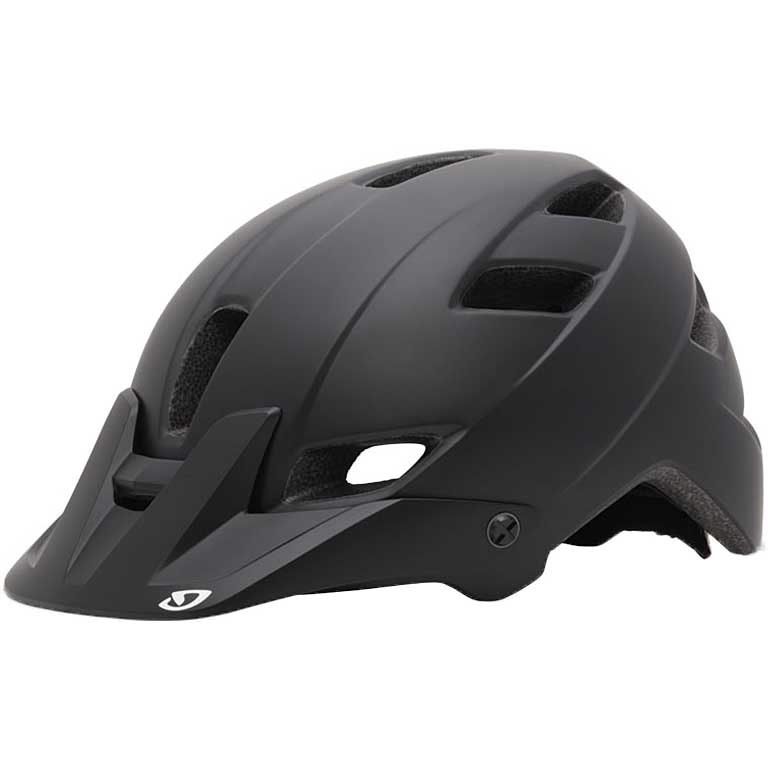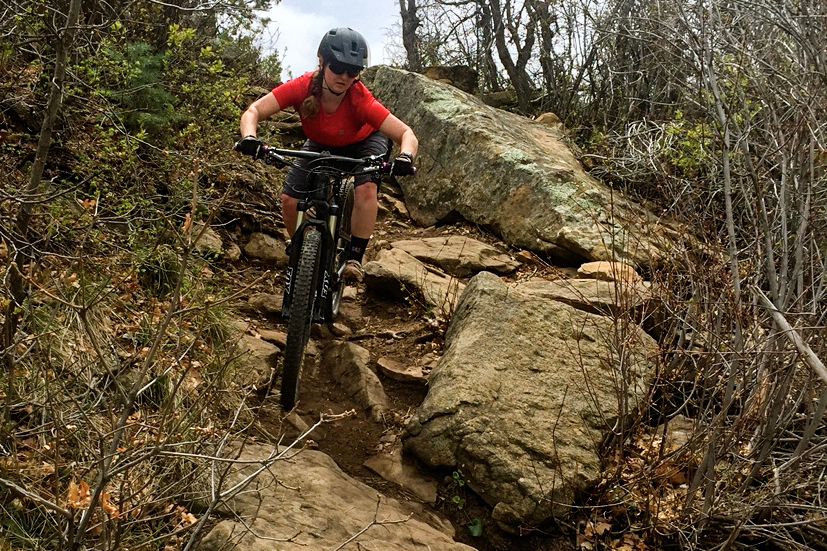
2nd Look: Giro Feature MIPS
Size: Small (51-55 cm)
Color: Matte Black
MSRP: $95
Specs and Features:
- MIPS (multi-directional impact protection system)
- In-Mold polycarbonate shell with EPS foam liner
- Adjustable moto-style visor
- In-Form fit system
- 12 vents with internal channeling
- Complies with U.S. CPSC Safety Standards
Reviewer: 5’2” 120 lbs. Head Circumference: 52 cm
Duration of Test: 2 months
Test Locations: all over Utah and Colorado
A few weeks ago Noah Bodman reviewed the Giro Feature MIPS helmet, and concluded that it offers superior safety features at a very reasonable price. For the past couple of months I’ve been riding in the Feature MIPS helmet as well, and have a few thoughts to add about this helmet.
Fit, Construction, and Related Features
I have the same impressions as Noah about the general fit of the Feature MIPS — it fits like a standard Giro. The design is geared toward oval-shaped rather than round heads (when looking at the head top down). Although my head is only very slightly oval-shaped, the Giro fits well with the adjustable “In Form” fit system.
The straps are low volume and lay flat, and it uses the standard Giro buckle, which is small and not cumbersome.
If your head is rounder and not a great fit for Giro helmets, the Bell Stoker MIPS may be a good option. The Stoker is similar to the Feature MIPS with a full-coverage design, MIPS, and the same MSRP ($95).
The full-coverage design of the Feature MIPS offers great protection and, in my opinion, is a very good choice for anyone who does not primarily race XC. This full-coverage construction and “In Form” fit adjustment dial (which is slightly larger than similar designs on the Troy Lee Designs A1 and Bell Stoker MIPS) make the bottom of the helmet sit quite low on the back of the head.
This causes a small problem for those who have long hair and like to keep it tied on the back of their head while riding. I have found that I can only keep my hair in a braid while riding in the Feature MIPS—a low ponytail pushes the helmet up and forward, and even a tight braid can cause the helmet to be pushed forward very slightly.
To counter this, I currently have the visor tilted almost as far up as it goes. This looks slightly dorky, but is worth it to be able to see the run-out of steep rock rolls.

As Noah described, venting heat is not something that the Feature MIPS excels at. The vents are fairly small and the plastic MIPS insert can create a slight greenhouse effect. Even riding in just 75° F temperatures under the blaring desert sun, I was uncomfortable.
Crashes and Safety
Noah wrote a great description of MIPS and how it functions in his review of the Feature MIPS, and you should read it.
I have had one substantial crash in this helmet.
The crash was a moderately high-speed impact where the side of my head hit the ground at an angle. In other words, it was a the kind of crash in which MIPS is specifically designed to mitigate damage.
I could feel that my head hit the ground, but it did not immediately seem to be too bad of an impact. Later, I realized that I had a headache and decided to end the ride early. My helmet got scratched, and there is a small dent in the polycarbonate shell around a vent.
The hit was bad enough for me to take almost a week off from mountain biking and start the process for a crash replacement warranty on the helmet. I have no idea how I would have felt if my helmet didn’t have MIPS, but based on previous crash experiences, I am willing to bet that it would have been a bit worse. And so for me personally, instances like this are enough for me to invest in a helmet with MIPS. When my brain is in question I’d rather be safe than sorry.
Price (and Protection)
At $95 USD, the price of the Giro Feature MIPS is comparable to many helmets that do not have this form of protection, and also comes in at about half the price of many others that do. For me, the cheaper price tag means that I can make safer decisions about throwing out a damaged helmet instead of worrying about getting rid of a $230 helmet that ‘maybe might still be ok.’
Bottom Line
The Giro Feature MIPS brings modern safety technologies into a mid-level performance helmet. While it isn’t the best ventilated helmet on the market, the Feature MIPS is a great trail/all-mountain helmet, and one of the most cost-effective ways to protect your brain cells.

Thanks for the personal experience write up. It hits home as I just had a crash with a 2 day headache. I wish I had MIPS. Would it have changed anything? I don’t know, but I’ll take even a small benefit when it comes to brain injuries.
The next 10 years will be interesting with helmet technology moving to brain protection rather than just skull protection.
P
As usual people assume that an addition like MIPS couldn’t in fact be counterproductive and lead to the helmet providing less protection. If nothing else the fact that it makes a helmet hotter compromises safety.
It’s almost funny that people are willing to compromise protection by making bicycle helmets shapes and designs that can snag on objects, and making them smaller than they should be so they don’t cover the whole head, yet they’ll go crazy for the MIPS fad.
It should also be noted that if the foam didn’t compress then it simply transferred the energy of the impact to your skull and brain.